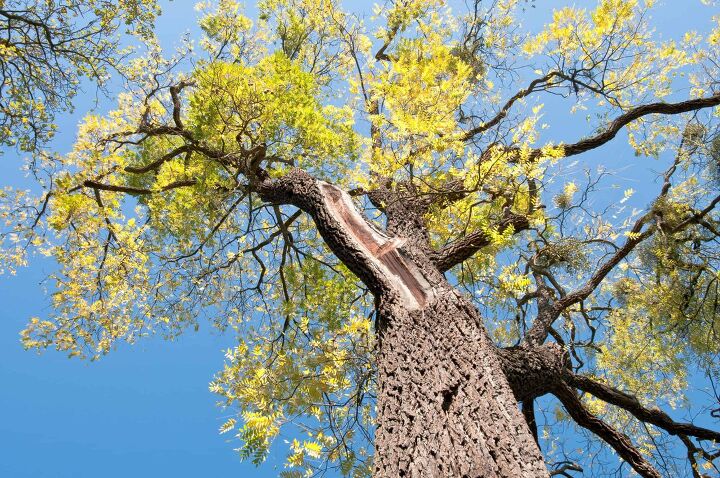How Much Is A Black Walnut Tree Worth?

Black walnut trees are sought after because they look great in any yard. Because of that, many builder-owners or large property owners looking to rejuvenate their landscape wonder just how much a black walnut tree is worth.
A black walnut tree in great condition with a large diameter, roughly 20”, is worth between $700 and $800. Through a walnut tree’s life, however, it can grow to be well over 30” or even 40” in diameter. The larger the diameter, the more a black walnut tree is worth. In fact, black walnut trees that are 40” in diameter can be worth $2,000 or more, depending on the lumber grade.
Because of that, many people grow black walnut trees for the purpose of selling them or their lumber. Others simply want to enjoy the great visual a black walnut tree provides while adding value to their yard.
Follow along as we dive into how much a black walnut tree is worth, and why.
Do You Need a Tree Service?
Get free, zero-commitment quotes from pro contractors near you.

Related Content: 25 Types of Palm Trees | Can I Deduct Tree Removal On My Taxes? | What Is A Good Tree To Plant Near A House?
What Affects a Black Walnut Tree’s Value?
The two main factors that affect a black walnut tree’s value are grade and veneer. Lumber grading is a way of testing and notating the quality of specific trees, such as black walnut trees, using measurements and math.
The veneer rating of a tree refers to a specific wood’s quality when sliced thinly into veneer. The final measure of a black walnut tree’s worth is the diameter. The diameter of a tree is measured using an instrument called a Biltmore stick.
At first glance, a Biltmore stick just looks like a yard stick, but its measurements can help determine the value of a black walnut tree. Black Walnut trees can grow to be 70-80 ft. tall and grow to have a diameter between 18” and 40” +, with rare occurrences of 80”-90” diameters. On the low end, a black walnut with 18” in diameter is worth $700.
If that tree were to grow to be 25” in diameter, it could be worth $1,200-$1400. The reason for diameter affecting a tree’s worth so much is that there is more volume for usable products. Larger diameter black walnut trees can produce more veneer and provide a lot of sellable lumber.
How is a Black Walnut Tree Graded?
A black walnut tree is graded based upon the clear wood rating within the lowest 16 ft. of its length past the stump. Clear wood is wood that is free of blemishes or damage, and it is desirable because it can be used to create any wooden products.
The grading scale used to rate trees is much like the one used in U.S. school systems, and it determines how valuable a tree is. No two tree species are alike or hold the same value.
| Grade | Condition |
| A | No clear damage, blemishes, knots |
| B | Minor blemishes, light damage |
| C | Small knots on one or both sides of the tree |
| D | Scratches and knots are more frequent |
| 1 | Many knots covering the entirety of the tree, some spots may be knot-free |
| 2 | Large knots in a high concentration, possible scratches, and damage |
Just like in school, you want your black walnut tree to have an A or B rating. The less knots, blemishes, and damage to the tree, the more valuable the black walnut tree is. A 25” A-rated black walnut tree would sell for $1,400+, whereas the same diameter with a B-rating would go for roughly $800.
Within the A and B range, black walnut trees are highly valuable. Once you get into the C, D, and 1 and 2 ratings, the tree depreciates in value.
Why Grow Black Walnut Trees?
For many large property owners, black walnut trees are a huge moneymaker, and that is why they grow them. There are countless products that can be crafted and sold using black walnut trees, such as:
- Veneer
- Gunstocks
- Acoustic guitars
- Furniture
- The walnuts themselves
Yes, even the walnuts that fall from black walnut trees can bring in money. Many black walnut tree owners are able to sell each 100 pounds of shelled black walnuts for $10-$12. That may not seem like a lot, but many healthy black walnut trees can produce 350 pounds a year.
The big money from black walnut trees comes from its lumber used to make products such as high-quality furniture. Black walnut lumber is sold by the board foot. Board foot refers to a 1 ft. length that is 1” thick. A common volume that black walnut lumber is sold in is 20 board ft.
The cost of 20 board ft. of black walnut lumber is $339-$350. That comes out to $16.95-$17.50 per board ft. of black walnut tree lumber. Because they can easily grow to be 70-80 feet or more, black walnut tree lumber can be sold for $1,356 at extremely low end.
If a black walnut tree is A-rated and has a wide diameter that is 20” or more, the lumber can easily sell for $1,400-$2,000.
Do Black Walnut Trees Really Harm the Plants Around Them?
Yes, it is true that black walnut trees can harm and even kill other plants or trees surrounding them. In fact, black walnut trees are known to produce a chemical known as juglone. Juglone is an organic compound that some plants, such as black walnut trees, produce.
The main harm that juglone does to other plants is stunt their growth. Because black walnut trees naturally produce juglone, often times, the plants in close proximity to them will cease to grow or even die.
Property owners can avoid the damage caused by juglone by planning their forest gardening. Avoid planting black walnut trees near gardens or other trees. There is no way to get a black walnut tree to stop producing juglone but spacing nearby plants out by a 50 ft. radius is the only sure way to avoid the effects of juglone.
How Long Before My Black Walnut Reaches Full Maturity?
It takes a full 30 years for a black walnut tree to reach full maturity. Many property owners will chop them down for lumber or to sell them well before then. However, if you plan on making money off of your black walnut tree, look at it as a long term investment.
The larger the tree, the more the lumber for you to sell. With that said, considering that black walnut trees can grow 70-80 ft., you may not want tree looming that large over your property. In that case, consider chopping it down once its diameter between 20” and 30”.
It is also worth noting that you should not wait 30 years for your black walnut tree to grow if it takes a lot of damage or grows nots. That will only depreciate its rating, and ultimately, its value. If and when your black walnut tree has a big diameter but is showing wear and tear, cut your losses before it gets worse, and cut it down for lumber.
Profitable Trees to Grow
Aside from black walnut trees, there are other trees you can grow and turn around for a profit. In fact, growing trees for profit is a great part- or full-time business for anyone who loves working with plants and being in the outdoors. Trees are an incredibly valuable, renewable resource that, although ideal, do not need a 100-acre tree farm. You can even grow trees for selling purposes in a tiny backyard.
For small growers, the most profitable trees tend to be the ones that are easy to grow, in demand by buyers, and elicit above-average pricing when sold. In addition to the black walnut, here are some trees that are worth growing if you’re looking to make some money:
- Instant shade trees. Mature, large trees that provide “instant shade” in just a year or two are highly desirable among both landscapers and homeowners alike. There are also willing to pay much higher prices for them as well. Two popular “instant shade” tree species are the American elm and the Red maple.
- Thornless locust. While the common locust is very often used for erosion control and restoration, newer varieties are more popular for landscaping projects. Both the Sunburst and Shademaster locust are fast-growing, thornless, and are even a great choice for an instant shade tree. They reach a mature height of 13 to 30 feet in just roughly six years.
- Hybrid Chestnut. These trees are blight-resistant chestnuts that offer the best of both Chinese and American chestnut trees. They can also be grown in most areas throughout the United States, especially in areas that are generally too hilly or poor for other crops. Hybrid chestnuts produce about 2,000 to 3,000 pounds of nuts per acre and their timber value is almost as high as the black walnut.
- Willow. As more people have taken up fiber arts in the last few years, the market craft fibers, or wood that can be woven, has nearly tripled. The willow tree is very easy to grow and prolific. In fact, one tree can produce hundreds of profitable willow shoots, or rods, every year.
- Flowering dogwood. The dogwood is frequently found on the top ten list for landscapers. They offer both colorful fall foliage and gorgeous spring blooms. The Kousa dogwood is one of the most desirable, as it produces sweet red berries, resistant to disease, and deer tend to leave it alone.
- Christmas trees. This may sound like an obvious option, but the “real” Christmas tree business is booming. Despite the fact that artificial trees exist, their sales are declining and the number of real trees is increasing ever year. If you have an acre or more of land, Christmas trees can make for a very profitable business. Consider this: fresh-cut trees sell for an average of $42 and one acre of land can hold roughly 1,800 trees!
If you’re looking to make a profit by growing trees, the black walnut isn’t your only option. However, they are one of the best choices, producing a double income since the nuts can be harvested as the tree is growing.
Do You Need a Tree Service?
Get free, zero-commitment quotes from pro contractors near you.

What Did We Learn?
On the low end, black walnut trees are worth $700 if it has an A or B rating and a minimum 20” diameter. Each 6” added to the diameter past the 20” mark greatly increases the value, with a 26” diameter black walnut going for $1,400 or more.
If you plan to make money off of your black walnut tree, pay attention to its quality and watch out for nots. An A or B rating can add hundreds and hundreds of dollars to how much money you can make off the veneer and lumber the black walnut tree produces.
Related Guides

Nick Durante is a professional writer with a primary focus on home improvement. When he is not writing about home improvement or taking on projects around the house, he likes to read and create art. He is always looking towards the newest trends in home improvement.
More by Nick Durante










![The 5 Best Angle Grinders – [2022 Reviews & Buyer's Guide]](https://cdn-fastly.upgradedhome.com/media/2023/07/31/9071326/the-5-best-angle-grinders-2022-reviews-buyer-s-guide.jpg?size=350x220)
















